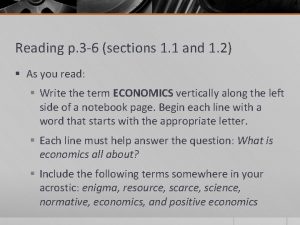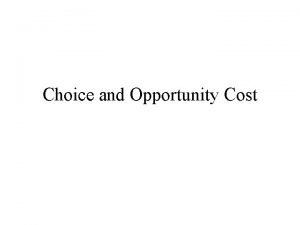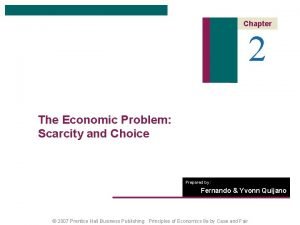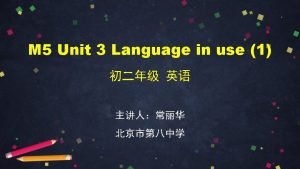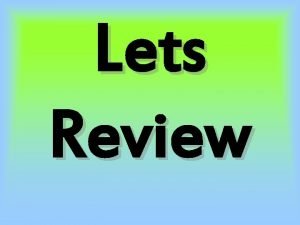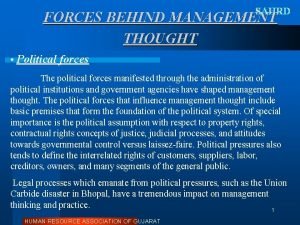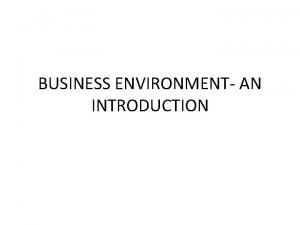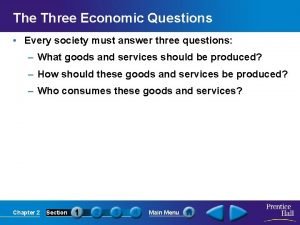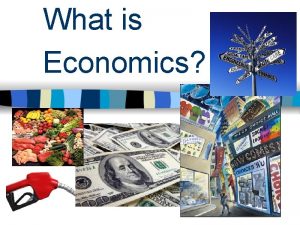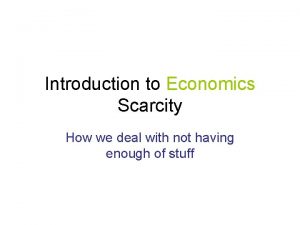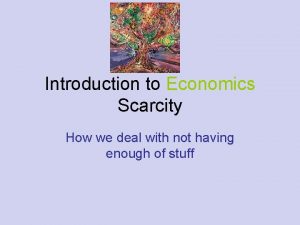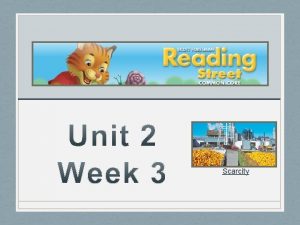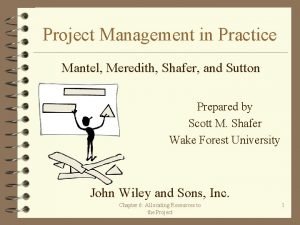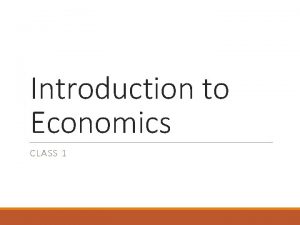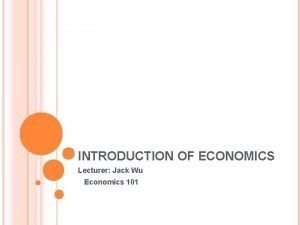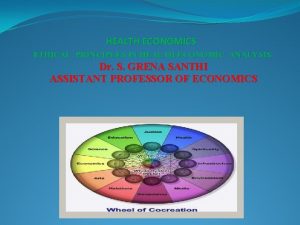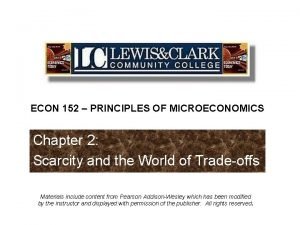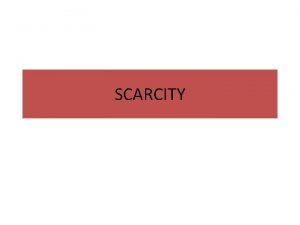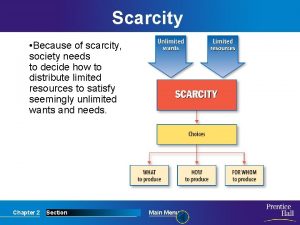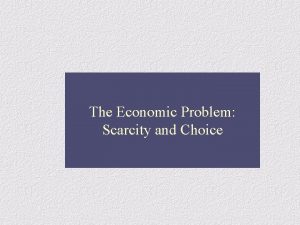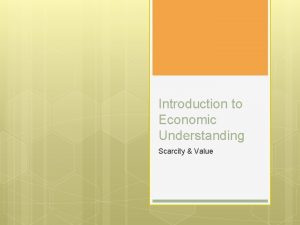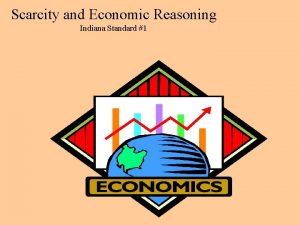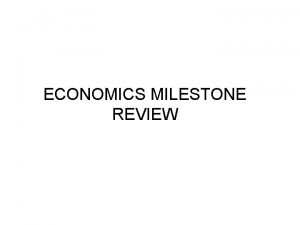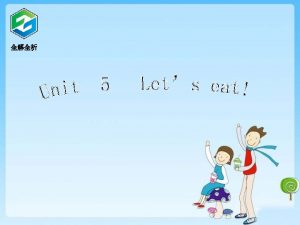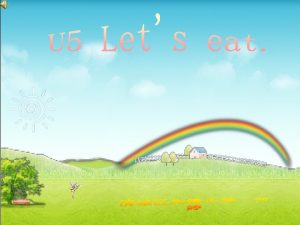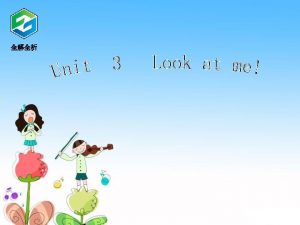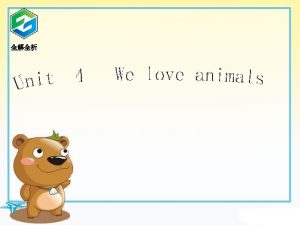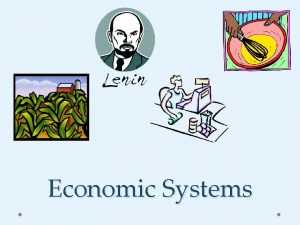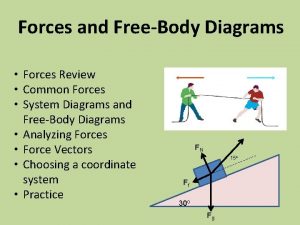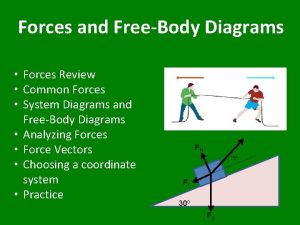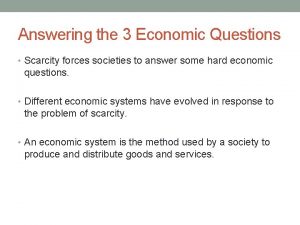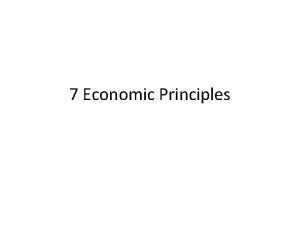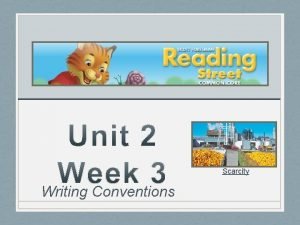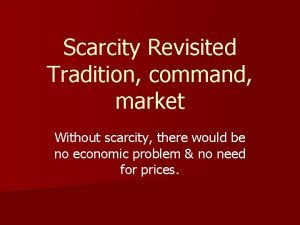ECONOMIC SYSTEMS Lets Review Scarcity forces society to






































- Slides: 38

ECONOMIC SYSTEMS

Let’s Review… • Scarcity forces society to ask 3 questions: v WHAT goods and services to produce v HOW to produce them v FOR WHOM to produce them

Learning Targets Knowledge • Distinguish between the various economic systems (traditional, market, command, mixed) Reasoning • Compare and contrast how the various economic systems (traditional, market, command, mixed) try to answer the questions: What to produce? How to produce it? For whom to produce? • Compare and contrast theoretical principles of the economic systems of capitalism, socialism, and communism. Skill • Use historical examples to provide evidence of the economic systems of capitalism, socialism, and communism their effectiveness.

Economic System • Organized way in which a society provides for the wants and needs of its people • 3 Major kinds exist: – Traditional – Command – Market

Command Economies • Rely on a central authority (ex: king, dictator, president) to make most of the economic decisions • Few exist today, because they tend to be unproductive

Command Economies Advantages Disadvantages • Capable of dramatic • Does not meet the wants and change in a short time needs of consumers • Many basic education, • Lacks effective incentives to get health, and other public people to work services available at little • Requires large bureaucracy, or no cost which consumes resources • Has little flexibility to deal with day-to-day changes • Lacks room for individual initiative



Traditional Economies • Use rituals, habits, or customs to answer the basic questions of WHAT, HOW, and FOR WHOM to produce • Roles are defined by the customs of their elders and ancestors

Traditional Economies • Found in rural, non-developed countries – some parts of Asia, Africa, South America and the Middle East • Technology is not used in traditional economies • Farming, hunting and gathering are done the same way as the generation before • Men and women are given different economic roles and tasks

Traditional Economics Advantages Disadvantages • Everyone knows which role to play • Tends to discourage new ideas and new ways of doing things

Market Economies • Consumers and businesses jointly answer the questions of WHAT, HOW, and FOR WHOM to produce • People make decisions in their own best interest

Market Economies Advantages Disadvantages • Individual freedom for everyone • Does not produce enough public goods such as • Able to adjust to change universal education, defense gradually or healthcare • Lack of government interference • Decentralized decision making • Workers and businesses face uncertainty as a result of • Large variety of goods and competition and change services • Rewards only productive • High degree of consumer resources satisfaction


Mixed Economies • Most economics in the world today feature some mix of traditional, command, and market economies.

Spectrum of Mixed Economies

Mixed Economies Advantages Disadvantages • Provides assistance for • Costs of benefits are some people who might higher overall (more otherwise be left out taxes) (too young, too old or too sick to provide for themselves)

Let’s Review. . . Who decides WHAT, HOW and FOR WHOM to produce? Traditional Command Market Rituals, roles, Central Authority Consumers and customs & habits Dictator, President, businesses jointly King Mixed


Who decides? • E. 6 Compare and contrast how the various economic systems try to answer the questions: What to produce? How to produce it? For whom to produce it for?

Pg. 44 -45 in book Name: __________ Date: ______Period : ______ Economic Freedom Economic Efficiency Economic Growth Economic and Social Goals Price Stability Full Employment Economic Equity Economic Security

Instructions 1. Bellwork. We will turn in. 2. Get out your college comparison assignment

Objectives • E. 3 Identify and explain the broad goals of economic policy such as freedom, efficiency, equity, security, growth, price stability, and full employment. (C, E) • E. 4 Describe how people respond predictably to positive and negative incentives. (C, E) • E. 5 Explain that voluntary exchange occurs when all participating parties expect to gain. (E) • E. 7 Describe how clearly defined and enforced property rights are essential to a market economy. (E)

NAFTA North American Free Trade Agreement • Through Congressional action, NAFTA came into effect on January 1, 1994 with the purpose of abolishing tariffs on goods and services traded between the U. S. , Canada and Mexico within 15 years. • Instructions: Evaluate based on the +, -, ? Ranking whether each of the following goals is achieved, not achieved or cannot be evaluated in relation to goal achievement.

NAFTA North American Free Trade Agreement • Through Congressional action, NAFTA came into effect on January 1, 1994 with the purpose of abolishing tariffs on goods and services traded between the U. S. , Canada and Mexico within 15 years. Goal: _____ Equity _____ Full Employment _____ Security _____ Economic Growth _____ Efficiency _____ Stability _____ Economic Freedom

National Health Care • National health care in the U. S. has been proposed in various forms for the past several years. The policy we are considering here is one of the first plans introduced – free and open health care for all those having no coverage. Approximated at 50 million people. Goal: _____ Equity _____ Full Employment _____ Security _____ Economic Growth _____ Efficiency _____ Stability _____ Economic Freedom

Note: Under capitalism, the basic economic decisions of WHAT, HOW, and FOR WHOM to produce are made through the free interaction of individuals looking out for their own best interest. AMERICAN FREE ENTERPRISE

Capitalistic Free Enterprise Economy has 5 important characteristics: 1. Economic Freedom • Individuals – – Buy what you want Occupational Freedom: Choose what you want to do, where you want to work and who you want to work for • Businesses – Hire the best workers – Produce what they want, at the price, quantity and location they want – Free to risk success or failure!

Capitalistic Free Enterprise Economy has 5 important characteristics: 2. Voluntary exchange – the act of buyers and sellers freely and willingly engaging in market transactions. 3. Private Property Rights – Allow people to own and control their possessions as they wish. 4. Profit Motive – People and organizations may improve their material well-being by making money.

Capitalistic Free Enterprise Economy has 5 important characteristics: 5. Competition - Producers and sellers compete with one another to attract consumers, while lowering costs. Consumers compete with one another to obtain the best products at the lowest price. Capitalism THRIVES on Competition!

Economic Detective The Blockster neighborhood is located on the outer edges of prosperous Green City. Although Blockster falls within the city limits of Green City, it is separated from the rest of the city by a large wide area of forest and grassland.

Economic Detective Living in Blockster presents problems for school age children. The school bus routes do not extend that far, and few households can provide their own transportation. Ms. Smarte sees an opportunity. She opens a private school in her garage and charges neighbors a fee for sending their children. Some Blockster residents refuse to pay Ms. Smarte’s fee; others think the convenience is worth it. Ms. Smarte is pleased with her earnings, but Blockster residents are unhappy with her limited curriculum. The next year, they elect a city council candidate who promises to bring school buses to Blockster. How does Ms. Smarte’s school demonstrate the following? 1. Economic Freedom: 2. Voluntary Exchange: 3. Self-Interest: 4. Profit Motive: How do residents influence the government to resolve Blockster’s school problem?

Who are the driving force of the economy? ENTREPRENEURS!!!

Role of Entrepreneurs • Organize land, capital, and labor in order to seek profit • Accept the risk of loss • Decide HOW to produce • Are innovators and catalyst

Role of Consumers • Decide WHAT is produced by how they spend their money • Spur development of new products by changing their wants

Role of Government • Act as protector, provider, and regulator, ensures and enforces that economic and social goals are carried out • Is a large consumer in the economy

How much should the government be involved with the economy? Who knows! But it is up to the voting public to decide!

Terms to Know… Test Review • Economic Systems – Traditional, Command, Market and Mixed (pg 32) – Distinguish between each – Advantages and Disadvantages – Current examples • 7 Economic and Social Goals (pg 44) • 5 Characteristics of Free Enterprise Capitalism (pg 49) • The Role of Consumers, Entrepreneurs and Government in the Economy (pg 50) • Communism, Socialism, Capitalism
 Scarcity forces tradeoffs
Scarcity forces tradeoffs Forces us to make choices.
Forces us to make choices. Definition of scarcity in economics
Definition of scarcity in economics Chapter 2 the economic problem: scarcity and choice
Chapter 2 the economic problem: scarcity and choice Chapter 1 lesson 2 our economic choices worksheet answers
Chapter 1 lesson 2 our economic choices worksheet answers Lets review cartoon
Lets review cartoon Is an integer subtracted by an integer always an integer
Is an integer subtracted by an integer always an integer Lets review
Lets review Differentiate between like and unlike parallel forces
Differentiate between like and unlike parallel forces The forces shown above are pushing/pulling forces
The forces shown above are pushing/pulling forces Intermolecular forces from strongest to weakest
Intermolecular forces from strongest to weakest Intermolecular forces vs intramolecular forces
Intermolecular forces vs intramolecular forces Inter vs intramolecular forces
Inter vs intramolecular forces Contact and non contact forces
Contact and non contact forces Net force
Net force What are destructive forces
What are destructive forces Political economic and social forces of management
Political economic and social forces of management Introduction of business environment
Introduction of business environment Economic growth vs economic development
Economic growth vs economic development Conclusion of growth and development
Conclusion of growth and development What were the forces holding feudal society together?
What were the forces holding feudal society together? Every society must answer the question of
Every society must answer the question of Economics
Economics What is economics
What is economics Scarcity lesson plan
Scarcity lesson plan Causes of scarcity
Causes of scarcity Causes of scarcity
Causes of scarcity Scarcity, choice and opportunity cost example
Scarcity, choice and opportunity cost example Er ir ur sentences
Er ir ur sentences Take home pay
Take home pay Entrepreneurship 3209
Entrepreneurship 3209 Resources scarcity
Resources scarcity Resources scarcity
Resources scarcity Resources scarcity
Resources scarcity Resources scarcity
Resources scarcity Resources scarcity
Resources scarcity Resources scarcity
Resources scarcity Scarcity
Scarcity Traditional economy cartoon
Traditional economy cartoon
